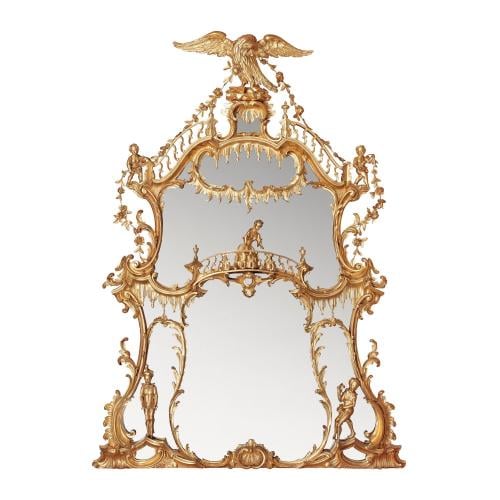- Furniture
- Lighting
- Clocks
- Vases
- Sculpture
- Marble Sculpture
- View all marble sculpture
- Marble figures & groups
- Marble panels
- Marble busts
- Search by Artist / Maker
- Ferdinand Barbedienne
- Franz Bergman
- Meissen porcelain
- Paintings
- Tableware
- View all Tableware
- Plates & dinnerware
- View all plates & dinnerware
- Plates
- Dinner services
- Dessert services
- Other dinnerware
- Popular Searches
- Antique silverware
- Antique glassware
- Russian enamelware
- Collectables
Chippendale, Thomas (English, 1718-1779)
Thomas Chippendale is one of, if not the most, notable name in the history of English furniture making. Born to John Chippendale, a joiner, in Yorkshire in 1718, it was presumed that he would also take occupation in the wood working trades.
Details of his early career are mostly unknown, but after training with Richard Wood in York, Chippendale moved to London in 1748, and his business was based in and around Covent Garden throughout his lifetime.
After setting up as a cabinetmaker, Chippendale published a pattern book in 1754 called The Gentleman and Cabinet-Maker’s Director, a seminal work which secured his eminence as an important maker of covetable furniture in 18th Century Britain. Published by subscription, it was an instant success and reissued twice in 1755 and 1762 to reflect changing tastes and fashions.
The publicity of his book brought Chippendale a wealth of customers and fantastic commissions. Designs included in Chippendale’s Director illustrated almost every type of domestic furniture one could want in the mid 18th Century. Most of these designs focussed on the Rococo style, which was popular throughout Europe at this point, to which he added his own modifications. Other styles included were Rococo versions of Chinese and Gothic designs. Both King Louis XVI of France and Catherine the Great of Russia owned copies of the Director.
Consequently, the name Chippendale came to be synonymous with the English Rococo style and even pieces that were not produced in his workshop were described as such.
Chippendale ran a large workshop – there were around 40-50 craftsmen working for him by 1755. It is probable that the hierarchy in his shop would not have seen him make furniture with his own hands – he would have most likely designed, promoted his designs and built relationships with clients.
Amongst his clients, Chippendale counted large commissions from the aristocracy, although interestingly he never secured work for royalty. His commissions saw his firm work as a large-scale interior design company, furnishing large and important houses throughout England and Scotland.
Chippendale had two business partners throughout his life, James Rannie and Thomas Haig, who were merchants and accountants respectively. This helped with late payments and the problematic cash flow of running a large business, as well as offering additional business acumen.
In the early 1760’s, Chippendale’s designs began to be influenced by Neoclassicism, which was sweeping across Europe, and he closely followed the work of Scottish furnituremaker and architect, Robert Adam. After his death in 1779, his son Thomas Chippendale the younger continued the business, working in the Neoclassical and Regency styles. The business went bankrupt in 1804, although after selling the stock and the Covent Garden premises, Chippendale continued to supply furniture until 1820.
Like many 18th Century styles, Chippendale designs saw a resurgence of popularity in the mid to late 19th Century, which saw his name adopted for the revival of the designs as a prestigious style amongst collectors until this day.
Filter

Sort





